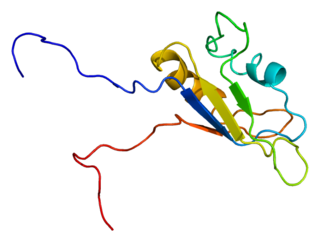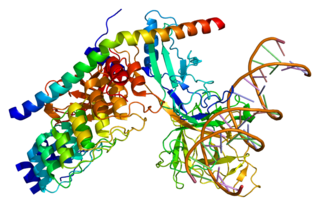Mastermind-like protein 2 is a protein that in humans is encoded by the MAML2 gene. [3] [4] [5]
Mastermind-like protein 2 is a protein that in humans is encoded by the MAML2 gene. [3] [4] [5]
Details on the activity of the N-terminal domain of Mastermind-like protein 2 may be found under MamL-1.

Adenoid cystic carcinoma is a rare type of cancer that can exist in many different body sites. This tumor most often occurs in the salivary glands, but it can also be found in many anatomic sites, including the breast, lacrimal gland, lung, brain, Bartholin gland, trachea, and the paranasal sinuses.

Mucoepidermoid carcinoma (MEC) is the most common type of minor salivary gland malignancy in adults. Mucoepidermoid carcinoma can also be found in other organs, such as bronchi, lacrimal sac, and thyroid gland.

The nuclear receptor 4A3 (NR4A3) also known as neuron-derived orphan receptor 1 (NOR1) is a protein that in humans is encoded by the NR4A3 gene. NR4A3 is a member of the nuclear receptor family of intracellular transcription factors.

RNA-binding protein EWS is a protein that in humans is encoded by the EWSR1 gene on human chromosome 22, specifically 22q12.2. It is one of 3 proteins in the FET protein family.

Anaplastic lymphoma kinase (ALK) also known as ALK tyrosine kinase receptor or CD246 is an enzyme that in humans is encoded by the ALK gene.

Protein SSX2 is a protein that in humans is encoded by the SSX2 gene.

CREB-regulated transcription coactivator 1 (CRTC1), previously referred to as TORC1 (Transducer Of Regulated CREB activity 1), is a protein that in humans is encoded by the CRTC1 gene. It is expressed in a limited number of tissues that include fetal brain and liver and adult heart, skeletal muscles, liver and salivary glands and various regions of the adult central nervous system.

Zinc finger protein PLAG1 is a protein that in humans is encoded by the PLAG1 gene.

Transmembrane protease, serine 2 is an enzyme that in humans is encoded by the TMPRSS2 gene. It belongs to the TMPRSS family of proteins, whose members are transmembrane proteins which have a serine protease activity. The TMPRSS2 protein is found in high concentration in the cell membranes of epithelial cells of the lung and of the prostate, but also in the heart, liver and gastrointestinal tract.

Protein SSX1 is a protein that in humans is encoded by the SSX1 gene.

Homeobox protein Hox-C13 is a protein that in humans is encoded by the HOXC13 gene.

Protein SSX4 is a protein that in humans is encoded by the SSX4 gene.

Zinc finger protein OZF is a protein that in humans is encoded by the ZNF146 gene.

Mastermind-like protein 1 is a protein that in humans is encoded by the MAML1 gene.

Breast carcinoma amplified sequence 3, also known as BCAS3, is a protein which in humans is encoded by the BCAS3 gene. BCAS3 is a gene that is amplified and overexpressed in breast cancer cells.

Protein SSX5 is a protein that in humans is encoded by the SSX5 gene.

Poromas are rare, benign, cutaneous adnexal tumors. Cutaneous adnexal tumors are a group of skin tumors consisting of tissues that have differentiated towards one or more of the four primary adnexal structures found in normal skin: hair follicles, sebaceous sweat glands, apocrine sweat glands, and eccrine sweat glands. Poromas are eccrine or apocrine sweat gland tumors derived from the cells in the terminal portion of these glands' ducts. This part of the sweat gland duct is termed the acrosyringium and had led to grouping poromas in the acrospiroma class of skin tumors. Here, poromas are regarded as distinct sweat gland tumors that differ from other sweat gland tumors by their characteristic clinical presentations, microscopic histopathology, and the genetic mutations that their neoplastic cells have recently been found to carry.

Protease, serine, 2 is a protein that in humans is encoded by the PRSS2 gene.

Mastermind-like 3 (Drosophila) is a protein that in humans is encoded by the MAML3 gene.
The nuclear protein in testis gene encodes a 1,132-amino acid protein termed NUT that is expressed almost exclusively in the testes, ovaries, and ciliary ganglion. NUT protein facilitates the acetylation of chromatin by histone acetyltransferase EP300 in testicular spermatids. This acetylation is a form of chromatin remodeling which compacts spermatid chromatin, a critical step required for the normal conduct of spermatogenesis, i.e. the maturation of spermatids into sperm. Male mice that lacked the mouse Nutm1 gene using a gene knockout method had abnormally small testes, lacked sperm in their cauda epididymis, and were completely sterile. These findings indicate that Nutm1 gene is essential for the development of normal fertility in male mice and suggest that the NUTM1 gene may play a similar role in men.